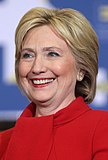2016 West Virginia Democratic presidential primary
| |||||||||||||||||||||||||
| |||||||||||||||||||||||||
 Election results by county. Bernie Sanders | |||||||||||||||||||||||||

The 2016 West Virginia Democratic presidential primary was held on May 10 in the U.S. state of West Virginia as one of the Democratic Party's primaries ahead of the 2016 presidential election.
The Republican Party held primaries in two states, including their own West Virginia primary, while for the Democratic Party this was the only primary on that day.
A heavily white, working-class state where voters were angry about the Obama administration's policies, Bernie Sanders easily outpolled Clinton in the Mountain State. Thirty percent of Democratic primary voters came from a coal household, and Sanders won 63 percent.[1]
Opinion polling
| List of polls | ||||||||||||||||||||||||||||||||||||||||||||||||||||||
|---|---|---|---|---|---|---|---|---|---|---|---|---|---|---|---|---|---|---|---|---|---|---|---|---|---|---|---|---|---|---|---|---|---|---|---|---|---|---|---|---|---|---|---|---|---|---|---|---|---|---|---|---|---|---|
|
Delegate count: 29 Pledged, 8 Unpledged
Winner:
|
Results
| West Virginia Democratic primary, May 10, 2016 | |||||
|---|---|---|---|---|---|
| Candidate | Popular vote | Delegates | |||
| Count | Percentage | Pledged | Unpledged | Total | |
| Bernie Sanders | 124,700 | 51.41% | 18 | 18 | |
| Hillary Clinton | 86,914 | 35.84% | 11 | 8 | 19 |
| Paul T. Farrell Jr. | 21,694 | 8.94% | |||
| Keith Judd | 4,460 | 1.84% | |||
| Martin O'Malley (withdrawn) | 3,796 | 1.57% | |||
| Rocky De La Fuente | 975 | 0.40% | |||
| Uncommitted | — | 0 | 0 | 0 | |
| Total | 242,539 | 100% | 29 | 8 | 37 |
| Source: [11][12] | |||||
Analysis
Although West Virginia had breathed new life into Clinton's 2008 presidential campaign eight years earlier, it failed to deliver for Clinton's front-running campaign in 2016. Clinton lost every county in the state to Bernie Sanders.
Sanders's West Virginia victory came from strong support among workers in the coal industry; fifty-five percent of West Virginia's Democratic voters with coal workers in their households voted for Sanders, while only 29 percent voted for Clinton.[13] His easy win was likely fueled by Clinton's comments in March about coal, "We're going to put a lot of coal miners and coal companies out of business."[14]
Analysts "speculate" Sanders's win in West Virginia came not from support for his own coal policies, but from a rejection of the Obama administration's.[15] Sanders was also helped by large numbers of Republican cross-over voters. Thirty-nine percent of Sanders voters stated they planned to vote for Donald Trump over Sanders in the November general election.[16]
References
- ^ "Bernie Sanders Wins West Virginia Primary". NPR.org. Retrieved 2021-01-23.
- ^ Primary results
- ^ "Overwhelming support for Trump, small lead for Sanders in MetroNews West Virginia Poll". MetroNews. 6 May 2016. Retrieved 6 May 2016.
- ^ "Trump, Sanders lead in West Virginia (april 2016)" (PDF). Scribd. Retrieved 3 May 2016.
- ^ "WV-Gov Thirty-Ninth Street Strategies for West Virginia Veterans (March 2016)". Scribd. Retrieved 21 April 2016.
- ^ "Poll: WV prefers GOP for president, Democrat for governor". wvgazettemail.com. 25 February 2016. Retrieved 2016-02-29.
- ^ "Trump and Sanders Have Big Leads in MetroNews West Virginia Poll" (PDF). wvmetronews.com. 22 February 2016. Archived from the original (PDF) on 2016-02-26. Retrieved 2016-02-22.
- ^ "Survey: WV residents likely to pick Trump over Clinton in 2016". Statejournal.com. Retrieved 2015-08-27.
- ^ "Trump leads Republican field and Clinton in West Virginia, according to new Orion Strategies statewide poll". prnewswire.com. 26 August 2015.
- ^ "Poll: Democrats running for WV gov locked in dead heat". Wvgazettemail.com/. 26 August 2015. Retrieved 2015-08-26.
- ^ The Green Papers
- ^ West Virginia Secretary of State
- ^ "How Anti-Coal Bernie Sanders Won Coal Country". 2016-05-12. Retrieved 2016-09-24.
- ^ "How Anti-Coal Bernie Sanders Won Coal Country". 2016-05-12. Retrieved 2016-09-24.
- ^ "How Anti-Coal Bernie Sanders Won Coal Country". 2016-05-12. Retrieved 2016-09-24.
- ^ "Donald Trump Supporters Boost Bernie Sanders in West Virginia". NBC News. Retrieved 2017-08-28.



